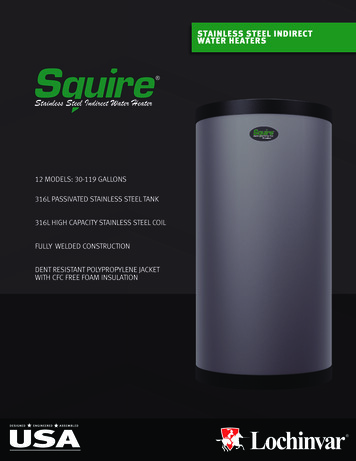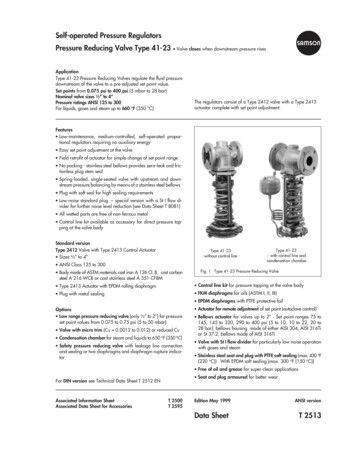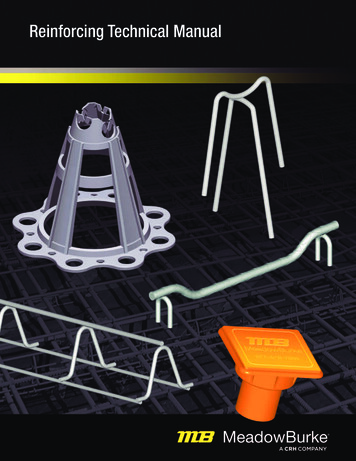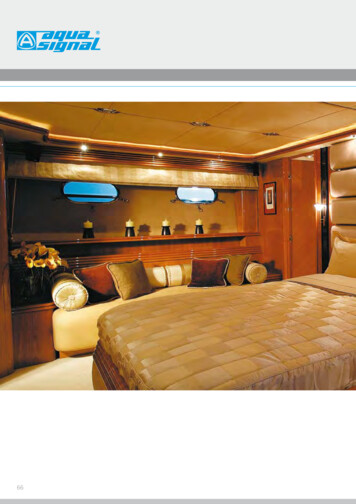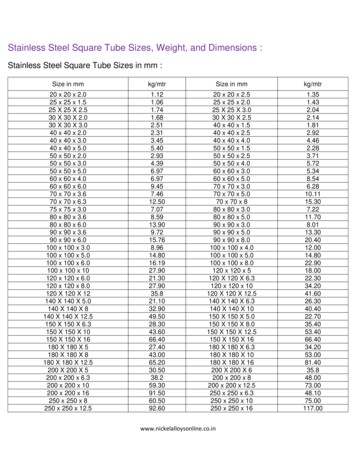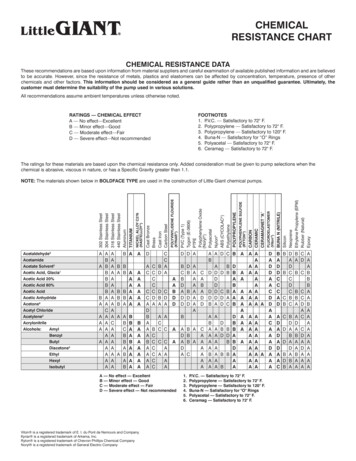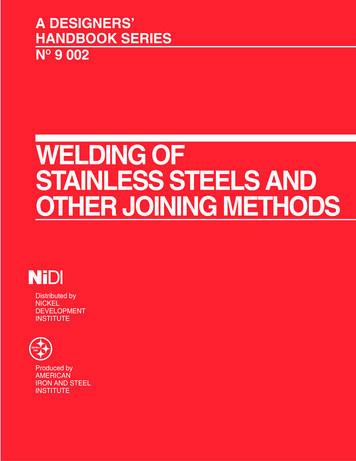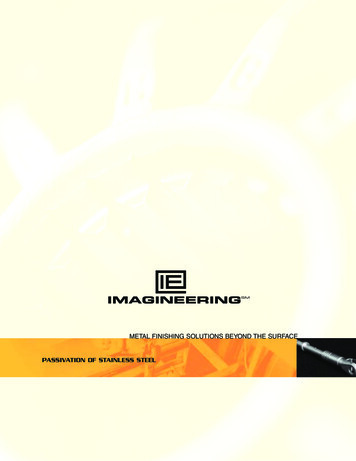
Transcription
91652.Green Material 4/25/00 9:37 AM Page 2DESIGNERS TA I N L E S SHANDBOOKSTEELTHE GREENM AT E R I A LStainlessSteelTheValueOption
91652.Green Material 4/25/00 9:37 AM Page 3T H E P R O D U C T I O N C Y C L E O F S TA I N L E S S S T E E LTA B L E O F C O N T E N T S THE PRODUCTION CYCLE OFSTAINLESS STEEL1What is Stainless Steel1Stainless Steel Industry2STAINLESS STEEL –THE MATERIAL ITSELF3Criteria For Evaluating The“Greenness” of Stainless Steel3Environmental Principles3Environmental Management Systems3Materials, Energy, Water Usage3Pollution Prevention4Waste Minimization4Recycling4Environmental Compliance Evaluations4Participation in CooperativeEnvironmental Councilsand Partnerships4Communication ofEnvironmental Activity4Environmental Releases andSustainable Relationship withthe Natural Environment4Health5Publications Available5The Making of Stainless Steel5Stainless Steel ProducersBCThe information included in this handbook hasbeen prepared for the general information of thereader based on information obtained or otherwiseavailable to the Specialty Steel Industry of NorthAmerica (SSINA). SSINA and the individualcompanies it represents have made every effortto ensure that information presented is technicallycorrect. However, neither the SSINA nor its membercompanies warrants the accuracy of the informationcontained in this handbook or its suitability for anygeneral and specific use. The SSINA assumes noliability or responsibility of any kind in connectionwith the use of this information. The reader isadvised that the material contained herein shouldnot be used or relied on for any specific or generalapplication without first securing competent advicewith respect to its suitability.SOCIETY HAS BECOMEI N C R E A S I N G LY C O N C E R N E DW I T H T H E H E A LT H O F T H EN AT U R A L E N V I R O N M E N T A N DT H E R O L E O F M AT E R I A L S I NI M PA C T I N G T H E E C O S Y S T E M .The recognition of and response toenvironmental concerns is often called“greening.” The “greenness” or quality ofenvironmental performance is leading someto consider this in materials selection.This designer handbook will attempt tooutline the numerous environmental considerations associated with the production,use and recyclability of stainless steel.Environmental evaluation criteria are identified and the performance of stainlesssteel against these criteria is noted inorder to assess the “greenness” of stainless steel. In order to understand andevaluate stainless steel as a material,a brief description of the productionprocess is outlined below:Exhibit 1 (see page 5) illustrates thetypical process for making a variety ofstainless steel products. The first step isthe selection of “raw material.” Thisconsists of recycled stainless steel scrap(usually 75 to 85% of the furnace charge)plus alloying elements such as chromium,nickel, molybdenum and others that willmake up the composition of the particulartype of stainless steel being produced.This material is then charged into anelectric furnace where it is melted. Onceliquefied, this charge is then transferred toan AOD (Argon Oxygen Decarburization)vessel, where the carbon content isreduced and the final chemistry is obtained.The gaseous releases from both of theseoperations are collected and the dustrecycled to reclaim the metallic compounds.The liquid stainless is then poured into acontinuous casting machine (or possiblyinto individual ingot molds) where itsolidifies into slabs or ingots. The slabs(or ingots) are then reheated and rolledor forged into hot bands (for sheet & stripproducts) or billets (for bar & wire products) or plates or structural shapes. Hotrolled sheet can then be further processedby cold rolling into cold rolled sheets andstrips. Billets can be either hot rolled further into hot rolled bars or rods. Bars canbe cold finished by turning or machining.Rods can be further processed by drawinginto wire.Table 1 shows the classifications ofvarious stainless steel product forms.Further information can be found inthe Designer Handbooks available fromthe Specialty Steel Industry of NorthAmerica (SSINA).W H AT I S S TA I N L E S S S T E E L ?Stainless steel is not a single alloy butrather the name applies to a group ofiron based alloys containing a minimumof 10.5% chromium. Other elements suchas nickel and molybdenum are added andthe chromium content increased toimprove corrosion resistance, improve heatresisting properties, and/or to improvefabricating characteristics. There are over60 stainless steel grades that were originally recognized by the American Iron andSteel Institute (AISI). It is the presenceof chromium that creates the invisiblesurface layer that prevents the rustingof the iron base by forming a complexchrome oxide that will not let oxygenattack the surface.1S TA I N L E S S S T E E LThe Ultimate Renewable Resource
91652.Green Material 4/25/00 9:37 AM Page 4Three general classifications are used toidentify stainless steel. They are:1. Metallurgical structure.2. The AISI numbering system(200, 300, 400 series).3. The Unified Numbering System, whichwas developed by the American Societyfor Testing Materials (ASTM) and theTable 1ITEMSociety of Automotive Engineers (SAE)to apply to all commercial metals andalloys.The various types of stainless steel aredetailed in a designer handbook, DesignGuidelines for the Selection and Use ofStainless Steel, available from the SSINA.C L A S S I F I C AT I O N O F S TA I N L E S S S T E E L P R O D U C T F O R M S TAINLESS STEELINDUSTRYThe stainless steel industry is a groupof companies that produce or processstainless steel products. Most belongto the Specialty Steel Industry of NorthAmerica (SSINA), a trade associationbased in Washington, DC. A listing ofmember companies is contained on theback cover of this handbook.WidthCoil and cut lengths:Hot Rolled No. 1under 0.1875" (4.76mm)24.000" (609.6mm) and overCold Rolled No. 2D, 2B,Bright Annealed, TRunder 0.1875" (4.76mm)24.000" (609.6mm) and overPolished No. 3, 4, 6, 7 & 8under 0.1875" (4.76mm)24.000" (609.6mm) and overCoils and cut lengths:Hot Rolled No. 1under 0.1875" (4.76mm)under 24.000" (609.6mm)Cold Rolled No. 2D, 2B,Bright Annealed, TRunder 0.1875" (4.76mm)under 24.000" (609.6mm)Polished No. 3, 4, 6, 7 & 8under 0.1875" (4.76mm)under 24.000" (609.6mm)Coils and cut lengths:Hot Rolled, annealed & pickled0.1875" (4.76mm) and overover 10.000" (254mm)Polished available forspecial applications0.1875" (4.76mm) and overover 10.000" (254mm)Straight lengths:Hot finished rounds, squares,octagons and hexagonsHot finished flats—0.125" (3.18mm) and over—Diameter or Size———0.250" (6.35mm)and over0.250" (6.35mm) to10.000" (254mm)—Cold finished rounds, squares,octagons and hexagons——Cold finished flats—0.375" (9.53mm) and overRodHot Rolled coils may be annealedand/or descaled——0.200" (5.54mm)and overWireCold finishes only:Rounds, squares, octagonsand hexagons——0.500" (12.7mm)and underFlat wire (coils only)Pipe &Tube0.010" (0.254mm) tounder 0.185" (4.76mm)0.062" (1.59mm)and over—0.062" (1.59mm) tounder 0.375" (9.53mm)Several different classifications with differing specifications are available.For information on standard sizes, consult your local Steel Service Center or the SSINA.Extrusions Not considered “standard” shapes, but available.Currently limited in size to approximately 6.50" (165.1mm) diameter circle, or structural to 5.00" (127mm) diameter.* Ingots, Slabs, Hot Bands, Angles and Rolled Shapes are also available2
91652.Green Material 4/25/00 10:30 AM Page 5S TA I N L E S S S T E E L – T H E M AT E R I A L I T S E L F C R I T E R I A F O R E VA L U AT I N GTHE “GREENNESS” OFS TA I N L E S S S T E E LA wide variety of criteria exists that canbe used to evaluate the environmentalperformance of stainless steel, asshown below.Criteria for Evaluating the Greennessof Stainless Steel1. Environmental Principles2. Environmental Management Systems3. Materials, Energy, Water Usage4. Pollution Prevention5. Waste Minimization6. Recycling7. Environmental Compliance Evaluations8. Participation in CooperativeEnvironmental Councils andPartnerships9. Communication of EnvironmentalActivity10. Environmental Releases andSustainable Relationship with theNatural Environment1 E N V I R O N M E N TA LPRINCIPLES3It is necessary to guide many corporateenvironmental actions. Therefore,developing an environmental policy isone of the most important componentsof environment management. Many ofthe producers of stainless steel in NorthAmerica have such a policy. Additionally,the SSINA has a statement of environmental principles. These principles areconsistent and similar to the environmentalpolicy of individual companies.SSINA member companies are committed to operating their facilities in compliance with applicable federal, state andlocal environmental laws and regulations,the promotion of environmentally andscientifically-sound and cost-effectivecorporate and public policies, while simultaneously fostering continued economicS TA I N L E S S S T E E Lgrowth. To fulfill this long-standing commitment, SSINA has adopted the followingguiding principles: Develop and integrate environmentalprograms into corporate policies andprocedures. Manage raw materials, byproducts,co-products, and wastes in compliancewith applicable federal, state, and localenvironmental laws and regulations. Consider environmental impacts whenevaluating new projects, technologies,and manufacturing processes. Promote the conservation of naturalresources, pollution prevention andminimization, and the legitimaterecycling and reuse of materials inmanufacturing processes. Encourage the research and development of improved manufacturing andenvironmental technologies and thewider use of long-lasting, recyclablespecialty steel products. Foster employee awareness of theirenvironmental responsibilities withincorporate policies. Respond appropriately to communityand customer information requests.2 E N V I R O N M E N TA LMANAGEMENTSYSTEMSCommitment from top management iscritical for the success of environmentalmanagement efforts. SSINA member companies have established an EnvironmentalAffairs Department analogous to themarketing and finance departments, ordesignated individuals, which addressenvironmental issues and interact withbusiness units in the corporation andregulatory agencies to assure compliancewith environmental regulations.3 M A T E R I A L S , E N E R G Y,WAT E R U S A G EThe environmental impact of the use of rawmaterials, energy, and water in the production of stainless steel is outlined below:RAW MATERIAL : Recycled stainless steel orother alloy scrap containing the basicelements that will form stainless steelafter melting in the electric furnace.Scrap is inspected for quality, content,and radiation as it enters the facilities.NOTE: Stainless steel is 100% recyclableand all available stainless steel scrap iscollected for recycling both from withinthe plant itself and from customers andfabricators after a useful life in the marketplace. Stainless steel does not requirea surface coating that can deteriorate topossibly pollute the environment.ALLOYING ELEMENTS :Generally consistof ferro-chrome and ferro-nickel that aremined and refined before being deliveredto the plant site. Environmental considerations for these products can be obtainedfrom the International ChromiumDevelopment Association and the NickelDevelopment Institute.SL AG : A byproduct of the electric furnacemelting operation. It is collected, metalsreclaimed, and the aggregate producedfor reuse or supply to other industries foruse, such as road bed material.ENERGY : The electric furnaces that areused to melt the raw materials are stateof-the-art with computer controls toensure the efficient use of electric power.Many companies contract with the utilitycompanies to use off-peak power and/or tolevel power usage in high demand periods.WATER USAGE : Water is used mainly asa cooling medium. Applications includeuse of a heat exchange medium for noncontact cooling process during hot rollingand in the “pickling” (acid wash) treatment after rolling. Many companiesrecycle most of their cooling waters upto 100 times prior to discharge.Excellence in Product Stewardship
91652.Green Material 4/25/00 10:30 AM Page 64 POLLUTIONPREVENTIONAIR EMISSIONS : The air emissions fromthe electric furnaces and AOD vessel arecollected via a series of ductwork andhoods, then routed to a high efficiencyfabric filter (bag house) where the solidparticles are collected and processed formetals recovery. The air emissions fromacid pickling are collected and routed to afume scrubber to remove the acid mists.Many acid pickling operations includechemical fume scrubbers for a greaterlevel of removal.WATER TREATMENT :All plant water iscollected and passed through a treatmentfacility. Wastewater is generated frommany different sources. Waters are treatedand re-used to the maximum extent feasible through the use of clarification andfiltration equipment that meets best available technology standards. Acid meteringequipment and acid recovery equipmentare utilized in the pickling process tominimize waste and recover used acid.5 WA S T E M I N I M I Z AT I O NWherever possible, minimization of wasteis a major objective in the stainless steelindustry. All discarded pieces of product(such as the tail ends and edge trims)are collected and segregated by type andreturned to the electric furnace as recycledin-house scrap. Packaging usually consistsof wrapping paper, steel bands, and woodencradles, all of which can and are recycledto reduce solid waste generation.6 RECYCLINGAs mentioned in the section on wasteminimization all stainless steel productsare 100% recyclable and have value evenafter a very long life as capital goodsor consumer products. Products like fastfood equipment, automotive exhaustsystems, kitchen sinks, boat shafting,aircraft parts, building roofs, etc., can allbe fully recycled after a useful life. In factthe long life of stainless steel productscontributes to resource minimization,since new resources are not neededas often to replace corroded or failedproducts. Stainless steel is collected bymetal scrap dealers all around the worldand sent back to the melt shop for usein producing new stainless steel. Thestainless steel that is processed in theelectric furnace is of the same qualityas the original and is not “downgraded”as is the case with some other so-calledrecycled materials.7 E N V I R O N M E N TA LCOMPLIANCEE VA L U AT I O N SEnvironmental compliance evaluationsinvolve examining the procedures andpractices to see if they meet legal andinternal requirements for good environmental practice. The member companiesof the SSINA use such practices.8 PA R T I C I PAT I O NI N C O O P E R AT I V EE N V I R O N M E N TA LCOUNCILS ANDPA R T N E R S H I P SThe stainless steel industry is involvedwith various governmental and environmental councils and partnerships. Theindustry and one member company wasa participating member in a task forcenamed the Common Sense Initiative. Themission of the task force, chaired by theAdministrator of the U.S. EnvironmentalProtection Agency, was to streamline regulations. Also, most member companieswere participants in the federal 33/50Program. This voluntary program reducedthe release and transfer of 17 targetedchemicals nationally by 50% based on1994 TRI data. Member companies alsoparticipate at the local levels by involvement in programs such as River Sweep,various watershed associations, pollutionprevention roundtables, Boy Scouts,regional air quality partnerships, countypicnics, leadership rolls in LEPC (LocalEmergency Planning Commission), WildTurkey Federation, Ducks Unlimited, private game reserves, wetlands recoveryprojects, and partners in spill responseactivities. They provide technical assistance upon request. Member companiesin Pennsylvania have collectively beenawarded the “Pennsylvania GovernorAward for Environmental Excellence,”receiving five awards in the past ten years.9 C O M M U N I C AT I O NO F E N V I R O N M E N TA LACTIVITYA measure of an organization’s commitment to the environment is its level ofcommunications. Member companieshave various levels of mechanisms tocommunicate environmental informationto others. Typical examples include:employee newspapers, environmentaltraining for employees, web pages, pressreleases, disclosure statements in 10Kforms, annual reports, environmentalreports, SSINA publications, presentationsto schools, chambers of commerce,Rotary clubs, etc.10 E N V I R O N M E N T A LRELEASES ANDS U S TA I N A B L ER E L AT I O N S H I PW I T H T H E N AT U R A LENVIRONMENTOne of the most commonly used indicators of environmental performance is theamount of hazardous and waste materialreleased. The specialty steel industry generates hazardous electric furnace dust andwaste pickle liquor. One hundred percentof the industry’s electric furnace dust isrecycled for metals recovery purposes andtherefore not discharged into the environment. Most companies operate acid recovery units to minimize generation of wastepickle liquor. All companies either recycleor treat waste pickle liquor, rendering itnon-hazardous prior to disposal.4
T H E M A K I N G A N D R E C Y C L I N G O F S TA I N L E S S S T E E L H E A LT HA study by EUROFER (EuropeanConfederation of Iron and SteelIndustries) published in January1999 entitled “Manufacture,Processing and Use of StainlessSteel: A Review of the Health Effects”CONCLUDED :1. Stainless steels themselves do notcause adverse effects on healthand so do not need to be classifiedas hazardous to health.2. There is no indication from theavailable data that the manufacture of stainless steel adverselyaffects the health of workers.3. The grinding and cutting of stainless steel do not appear to causeany adverse health effects.4. The welding of stainless steel doesnot cause any stainless-steelspecific increase in the risk of lungcancer over and above theincreased risk from any steelwelding.ABDALLOYS and STEEL SCRAPto ELECTRIC FURNACEAOD VESSEL toMOLTEN STAINLESSSTEELto INGOTS to SOAKINGPIT to BLOOMING /SL ABBING MILLto BLOOM / BILLETS toI L U STRUCTURAL SHAPES /BAR / WIRERODS / WIREororCEto CONTINUOUSCASTINGto SL ABS to HOT ROLLEDSHEET AND STRIP toCOLD MILL/SENDZIMIR MILLto COLD ROLLED SHEET /STRIP / PL ATEor SL ABS to PL ATESDBCA1EP U B L I C AT I O N SAVA I L A B L E“Full Life Cycle of Stainless Steel –The Right Material for ourEnvironment”Published by the SSINA“Manufacture, Processing, and Useof Stainless Steel: A Review of theHealth Effects”Published by EUROFER (January 1999)Minimization of waste isa major objective in thestainless steel industry.All discarded pieces ofproduct (such as the tailR E C Y C L Eends and edge trims) arecollected and segregatedby type and returned tothe electric furnace asrecycled in-house scrap.Stainless steel productsare 100% recyclableand have value evenafter a very long life ascapital goods or consumerproducts. Stainless steelproducts can be fullyrecycled after a useful life.5S TA I N L E S S S T E E L100% RecyclableRR EE CCYYCC LL EE
91652.Green Material 4/25/00 10:46 AM Page 8FFto END USES6RREECCYYCC LL EERECYCLE
Society of Automotive Engineers (SAE) to apply to all commercial metals and alloys. The various types of stainless steel are detailed in a designer handbook, Design Guidelines for the Selection and Use of Stainless Steel,available from the SSINA. STAINLESS STEEL INDUSTRY The stainless steel industry is a group of companies that produce or process
